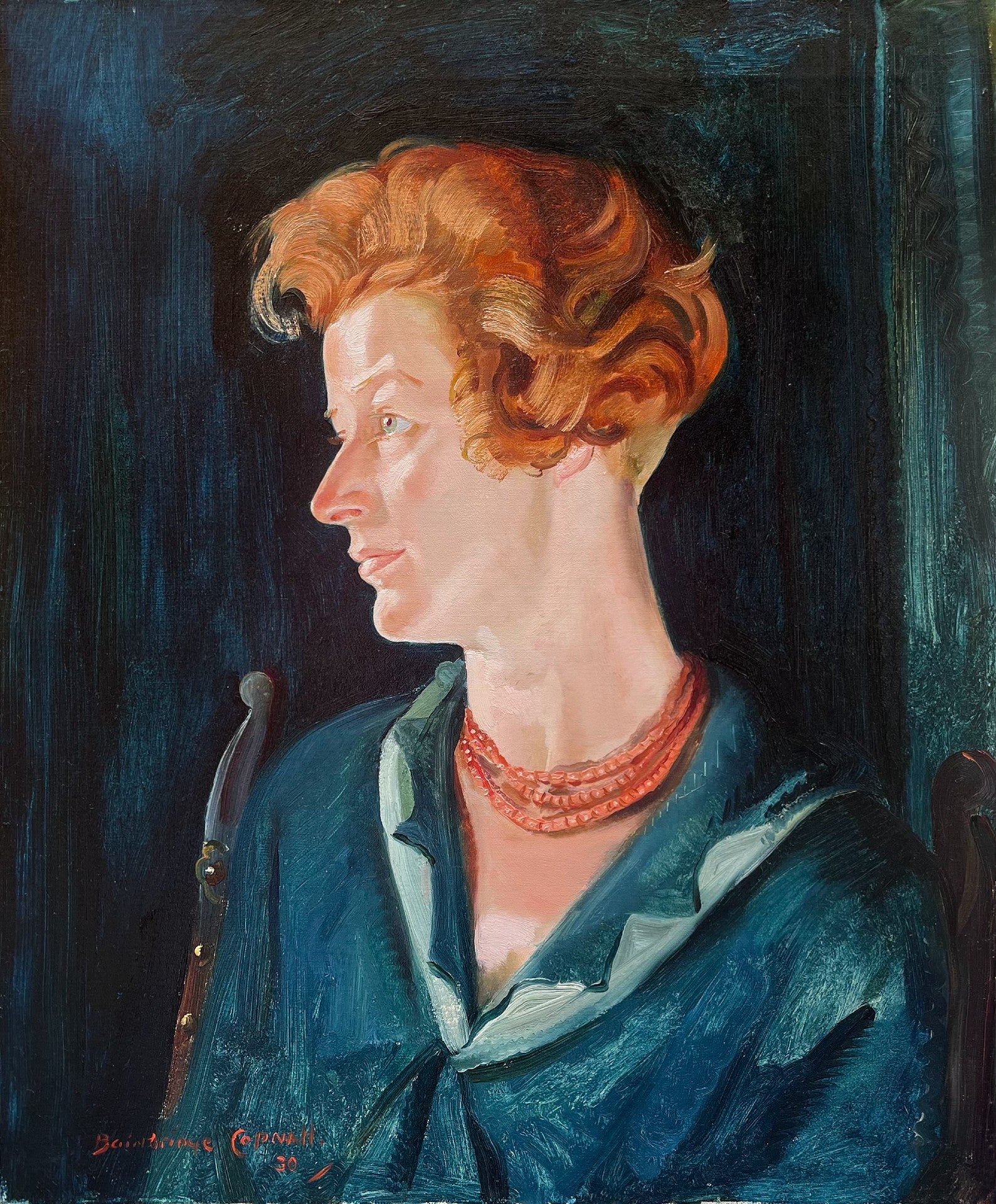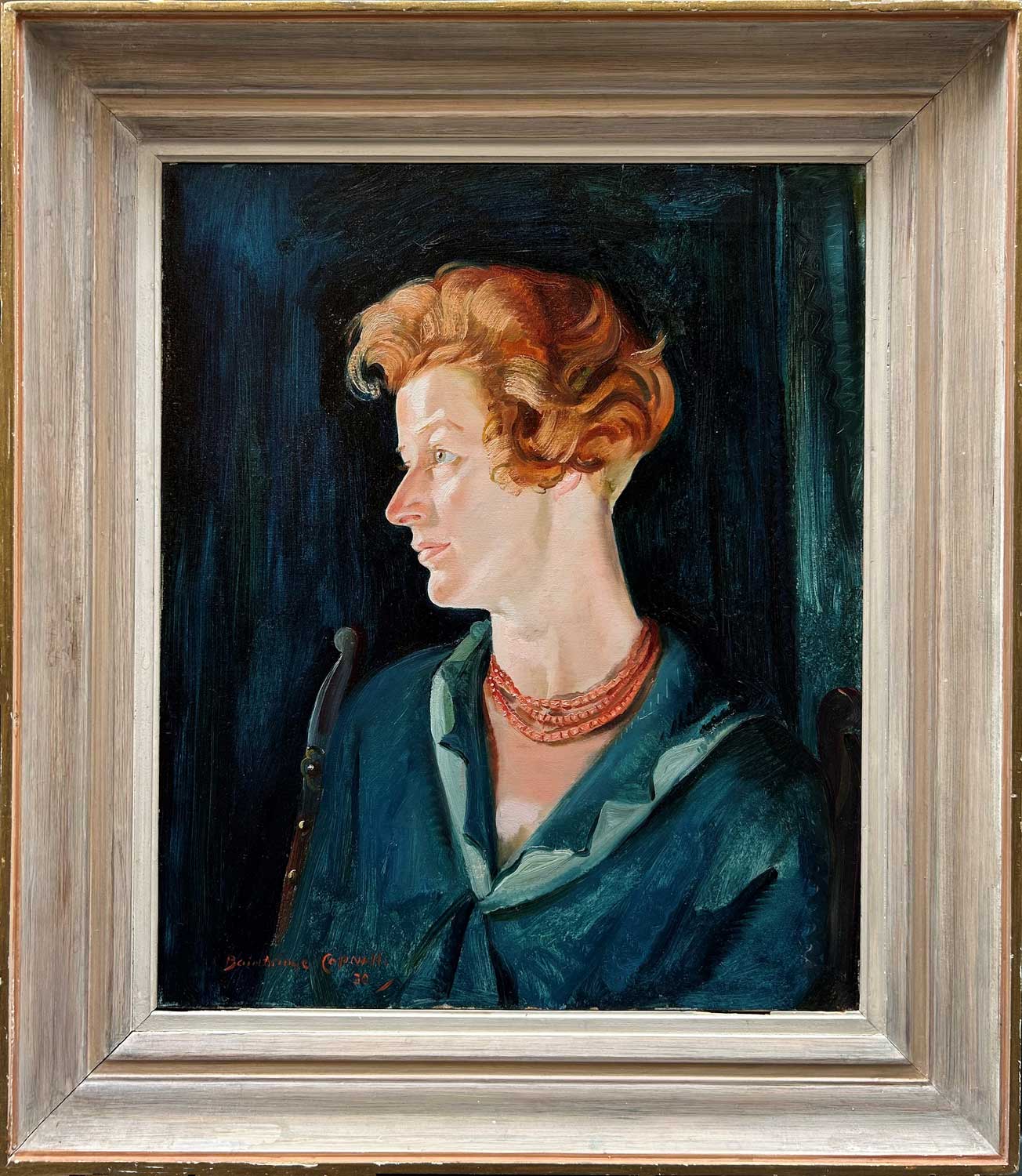

Edward Bainbridge Copnall
Portrait of a Lady in Blue
Oil on canvas, signed & dated '30' lower left
Image Size: 24 x 20 inches (61 x 50.7 cm)
Contemporary frame
This portrait depicts a red-headed lady at a near side-profile to the viewer. She sports a dark teal dress, as well as a simple beaded necklace that almost matches the colour of her hair. The sitter is lit dramatically from the direction that she faces, with small dots of light reflecting from her pale green eyes.
The colours within the image are striking and are interestingly very similar. The dark teal of the dress is a close match to the dark blue background of the work, whilst the sitter’s hair colour is immensely similar to the colour of the beads around her neck. This creates a cohesive composition that keeps attention on the sitter, aided by Copnall’s masterful use of lighting to ensure that she stands out from the chromatically similar background.
The painting depicts the sitter in a realistic style. Her skin is pale due to the dramatic lighting, which also highlights dewy areas on her forehead and cheeks. Copnall displays a keen attention to this lighting, depicting white areas for those that would reflect the most light if illuminated in this manner, whilst ensuring her neck, side of her nose and her jaw are kept in slight darkness. The woman’s hair is fantastically detailed, with Copnall using different shades of orange and auburn to denote different areas of light and dark.
This intense realism contrasts noticeably with the lack of detail in the background, cementing the viewer’s attention on the sitter rather than unnecessary background embellishment. Interestingly, the background and the sitter’s dresses demonstrates an element of brush experimentation on Copnall’s behalf, with bizarre zigzags made with the end of the brush’s handle and squiggly strokes on the right side.
Edward Bainbridge Copnall
Edward Bainbridge Copnall was born in Cape Town, South Africa in 1903. After the death of his mother when he was a toddler, Copnall relocated to Horsham with his father and was cared for by his godparents. Copnall’s uncle was eminent portrait painter Frank Thomas Copnall, and he helped Copnall win commissions from established sitters.
Copnall studied at Goldsmiths School of Art and the Royal Academy, initially starting his artistic career as a painter. He followed in the footsteps of his uncle by painting portraits, before he became acquainted with the sculptor Eric Kennington. From this point, Copnall began to work in sculpture and architectural decoration, which became the mediums he is most associated with. Copnall was a prolific exhibitor of his art, exhibiting at the RA, the London Gallery, the Paris Salon, the Royal Society of Arts, and the New English Art Club. He received important commissions for the Adelphi Building and the Royal Institute of British Architects Building on Portland Place before the outbreak of war.
During the Second World War, Copnall used his artistic skills to work as a camouflage officer as part of Operation Crusader in the Middle East. He was awarded the MBE after the war for his service.
In the post-war period, Copnall was the head of the Sir John Cass School of Art and undertook a number of commissions, such as The Lambeth Preacher. He then travelled to Burma for a year and returned to painting, creating up to 60 works of art whilst there. Whilst there, Copnall was commissioned to create a sculpture of General Aung San, Burma’s first Prime Minister. Returning to England, Copnall completed more commissions for St James’ House and Stag Square. He became President of the Royal Society of British Sculptures in 1961, until 1966. He published A Sculptor’s Manual in 1971, which recounted his experiments using fibreglass resin as a medium for his acclaimed Becket sculpture in St Paul’s Cathedral churchyard.
Edward Bainbridge Copnall passed away in 1973, leaving behind a strong legacy of decorative sculpture and cementing himself as an artist known for allegorical and religious subject matter. His son, John, was also an acclaimed artist.



